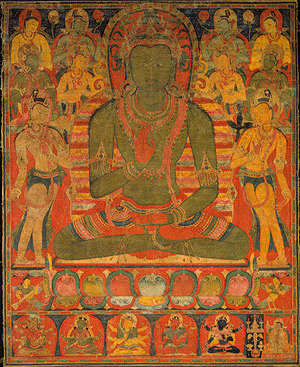The Metropolitan Museum of Art – New York
Tibet (Central regions)
Distemper on cloth
Purchase, Miriam and Ira D. Wallach Philanthropic Fund Gift, 1991 (1991.74)
The Buddha’s broad shoulders, defined waist, and long legs derive from Indian artistic traditions that were transmitted to Tibet along with Buddhism between the tenth and the twelfth centuries. Identified by his green color, Buddha Amoghasiddhi is one of a group of five celestial (as opposed to historical) Buddhas that are understood to head five families of deities. He is associated with the north, heads the action family, and symbolizes an all-encompassing awareness.
Eight bejeweled and crowned bodhisattvas (beings who have attained a deeper awareness but remain in the physical world to guide others) attend the Buddha; two are at his sides and six are seated above. The bodhisattvas allude to the Mandala of the Eight Great Bodhisattvas, one of the earliest renderings of the cosmic diagrams that characterize later Tibetan art. This painting belonged to a group illustrating the five celestial Buddhas. While two other works from the set are known today, the Museum’s is the only one that includes an image of a monk (foreground); he may represent the cleric responsible for consecrating the set.





